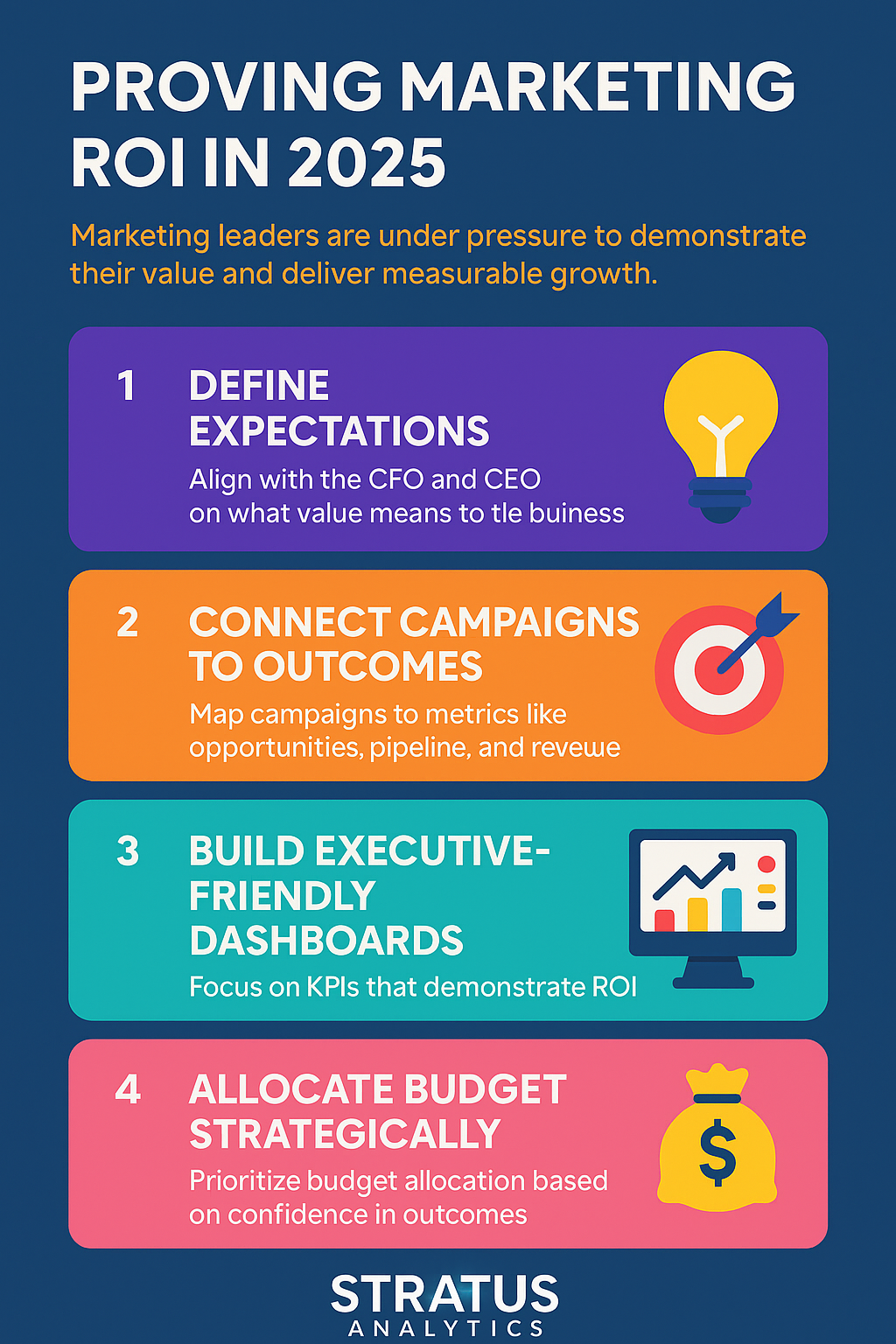Marketing leaders are under more pressure than ever to deliver marketing ROI.
You’re either being asked to do more with less or handed more budget and told to turn it into pipeline. And in both cases, you’re operating with partial data, broken attribution, and the lingering fear that one wrong move will tank your credibility.
It’s not just about performance anymore. It’s about survival.
In 2025, proving marketing ROI isn’t a nice-to-have—it’s the difference between building long-term impact or getting swept out with the next budget cut. But proving value has never been more complex. Attribution is murky. Pipelines stall. Your reporting feels disconnected from what’s actually moving the needle.
And worst of all? You’re spending most of your time justifying your existence instead of executing strategy.
This post is about fixing that.

Why Marketing ROI Feels So Hard to Measure
The first problem is the disconnect between what marketing teams do and what finance teams measure.
You’re running multi-channel campaigns. You’re nurturing leads. You’re building brand equity. But your CFO wants clear, direct cause-and-effect between dollars in and revenue out.
And attribution? It’s a black box.
Multi-touch attribution models are flawed. First-touch and last-touch reporting tell incomplete stories. Incrementality testing is expensive and hard to scale. And yet you’re still expected to deliver a clear answer to “what’s working?”
So instead, you scramble. You piece together dashboards. You stretch UTM parameters into justification. You rely on short-term indicators—CPLs, form fills, demo requests—even if they don’t lead to qualified pipeline.
All of it feeds the illusion of control, while making real insight harder to come by.
The Real Job of Marketing Leaders in 2025
It’s tempting to focus on platform tactics. To tweak audiences in LinkedIn. To optimize your Google Ads quality score. And yes, those things matter.
But if you’re a CMO or marketing director right now, your real job isn’t ad optimization. It’s value creation—and value communication.
Your role is to:
- Build the narrative that marketing is a revenue engine, not a cost center
- Align marketing metrics with business outcomes
- Create frameworks for tracking performance that the executive team understands
- Shield your team from the chaos so they can execute
Marketing ROI isn’t just a number—it’s a story. And you’re the one responsible for telling it well.
A Framework for Proving and Driving Marketing ROI
To get out of reactive mode and into strategic territory, you need structure. Below is a 4-part framework to help marketing leaders prove and grow ROI in 2025.
1. Define What “Value” Means to the Business
Start with alignment. Meet with your CFO, CEO, or board. Ask what success looks like from their perspective.
It’s usually not traffic, leads, or impressions—it’s qualified pipeline, deal velocity, customer retention, and cost efficiency. So build your scorecard around those metrics.
Clarify:
- What counts as a “qualified lead”
- What the average sales cycle looks like
- What CAC thresholds are acceptable
- What percentage of marketing-sourced pipeline is expected
Only then can you build a measurement model that reflects business reality.
2. Connect Campaigns to Commercial Outcomes
Once you’ve defined success, work backwards.
Instead of reporting clicks or leads, focus on what those leads became:
- Which campaigns led to SQLs?
- What channels generated revenue, not just volume?
- Which content offers accelerated deal velocity?
Use CRM and revenue attribution tools to create closed-loop reporting. Map form fills and MQLs to pipeline contribution. Even if the data is imperfect, directional insight is better than none.
And document everything. CFOs don’t care how creative your ads are—they care whether they convert.
3. Build Executive-Friendly Dashboards
Your dashboard isn’t for you—it’s for the people funding your work.
Ditch vanity metrics. Highlight ROI indicators:
- Cost per pipeline opportunity
- Marketing-sourced revenue
- Channel-level efficiency
- Sales-assisted conversion rates
Make it visual, accessible, and updated regularly. If your leadership team can’t read your dashboard in under 60 seconds, it’s not doing its job.
4. Allocate Budget Based on Confidence, Not Habit
Budgeting shouldn’t be about copying last year’s spend or chasing trends.
Use your measurement framework to categorize campaigns into tiers:
- High confidence: Clear ROI, proven conversion to revenue
- Medium confidence: Promising indicators, but still maturing
- Low confidence: Experimental or brand-building with unclear payoff
This lets you allocate your budget proportionally—and defend those decisions. It also gives you breathing room to invest in long-term plays without sacrificing performance.
The Cost of Short-Term Thinking
Here’s what’s killing marketing performance right now: short-termism.
Campaigns are being cut too soon. Teams are being pushed to deliver results on timelines that don’t reflect reality. Strategic bets are being dismissed because they don’t create instant gratification.
But great marketing takes time. Brand equity takes time. Demand creation takes time.
If you want to prove marketing ROI, you have to educate the executive team on what that timeline looks like—and set the expectation that smart growth isn’t always immediate.
If you don’t, you’ll keep chasing tactics, pivoting every quarter, and never building the foundation needed for scalable success.
The Rise of AI Fear and the Real Job Threat
On top of all this pressure, you’re also being told that AI is coming for your job.
Thought leaders post daily about how you’re falling behind. That others are smarter, faster, more efficient. That your traditional marketing playbook is obsolete.
And while yes, AI is changing the game, it’s not replacing marketers who know how to lead. It’s replacing marketers who rely on templates and guesswork.
The antidote to fear isn’t more hustle—it’s more strategy.
Your value is not in how many campaigns you run. It’s in how clearly you can connect those campaigns to business results. That’s what protects your role. That’s what moves your company forward.
Shifting the Focus: From Clicks to Clarity
In the past, I focused most of my content on ad performance—cost per lead, keyword selection, platform-specific optimizations.
Not anymore.
Because no one is losing sleep over a 12% drop in CTR. You’re losing sleep over whether you’re making the right decisions with limited time, budget, and trust. You’re looking for clarity. Direction. A way to bring structure to chaos.
That’s the real role of a modern marketing leader. And it’s what I’ll be focusing on more going forward.
Final Thoughts on Marketing ROI and Leadership
If you feel like you’re stuck in a loop—reporting more than executing, optimizing without impact, defending your spend with partial data—you’re not alone.
But you don’t have to stay there.
The path forward isn’t found in one magic dashboard or one perfect campaign. It’s found in building a repeatable, defensible, strategy-led system for proving and driving growth.
That’s how you show that marketing isn’t a cost center—it’s the engine of your business.
And that’s how you earn the resources, trust, and freedom to do your best work.

Hi there! I’m Scott, and I am the principal consultant and thought leader behind Stratus Analytics. I have a Master of Science degree in marketing analytics, and I’ve have been providing freelance digital marketing services for over 20 years. Additionally, I have written several books on marketing which you can find here on Amazon or this website.
DISCLAIMER: Due to my work in the packaging industry, I cannot take on freelance clients within the packaging manufacturing space. I do not want to provide disservice to your vision or my employer. Thank you for understanding.
